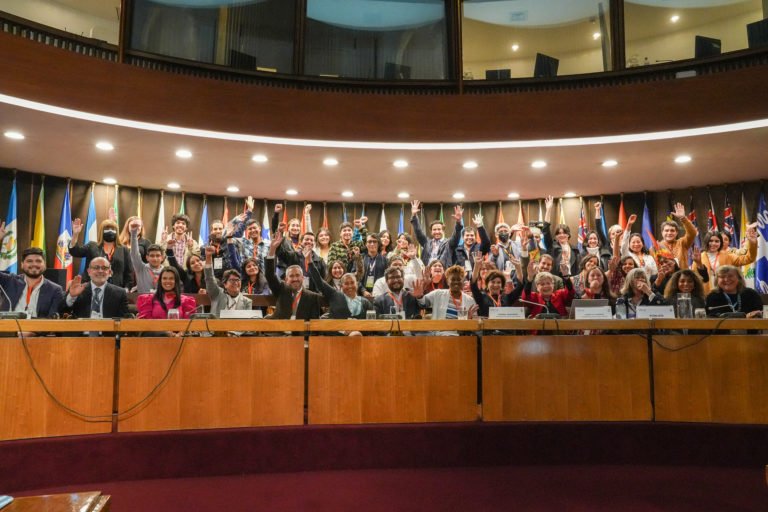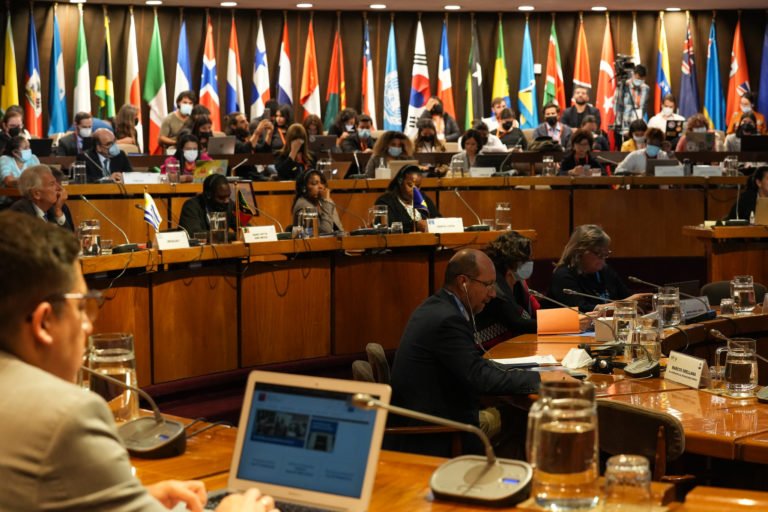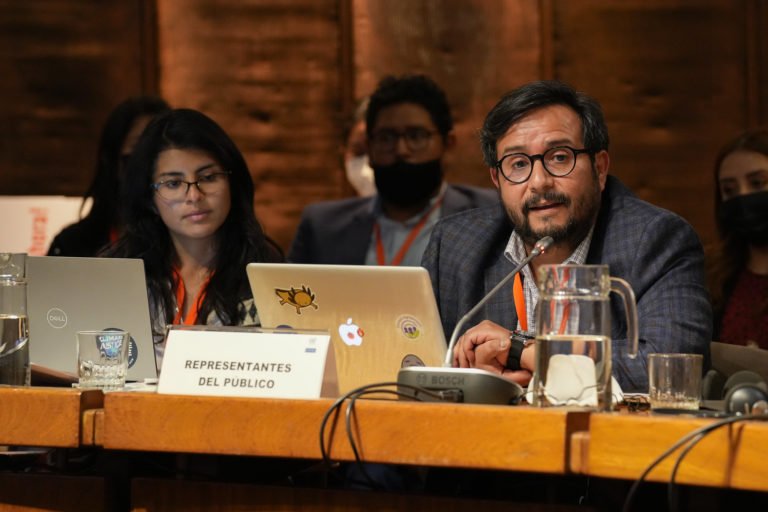- The first conference of the parties to the Escazú Agreement concluded with the approval to include the public in the board of directors and finalize the rules surrounding a committee that will oversee compliance with the treaty. These were described as some of the greatest achievements of the conference.
- The Escazú Agreement is a regional treaty in Latin America and the Caribbean that promotes access to environmental information, compliance with environmental laws and environmental justice. It is also known as a treaty that addresses the protection of environmental defenders.
- Indigenous and youth groups played a large role in the conference which announced a task force focused on monitoring the situation surrounding environmental defenders in the region.
- Elections for the positions of public representative to channel citizens’ demands will be held in August and any citizen of a country which ratified the Escazú Agreement can register to run.
During the first conference of the parties to the Escazú Agreement (COP 1) held in April in Santiago, Chile, Indigenous leader Nadino Calapucha asked participants to respect the heart of the treaty – characterized by the inclusion of citizens.
The Escazú Agreement is a regional treaty in Latin America and the Caribbean that promotes timely access to environmental information, participation in decision-making that affects the environment and access to justice to ensure compliance with environmental laws and rights. It is also known as a treaty that addresses the protection of environmental defenders.
“Eliminating the participation of the public is removing the very spirit of this agreement,” said Calapucha, a member of the Coordinator of Indigenous Organizations of the Amazon River Basin (COICA), during COP1’s first meeting.
The moment was sparked by several tense minutes during the negotiations on the morning of Thursday, April 21, when the Bolivian delegation presented a project that would eliminate the inclusion of the public in the board of directors.
Establishing public participation during the three days of the event became the main point of the debate.
Though, during the course of the conference, the large presence of environmental activists, youth groups, and Indigenous representatives, contributed to what became a democratic event.
During the first meeting of States Parties to the Escazú Agreement, participants also approved the procedural rules for future meetings and the creation of a Committee to Support Implementation and Compliance. Up to this point, there are 12 countries that have completed the ratification process of this regional environmental treaty. These States Parties are: Antigua and Barbuda, Argentina, Bolivia, Ecuador, Guyana, Mexico, Nicaragua, Panama, Saint Vincent and the Grenadines, Saint Kitts and Nevis, Saint Lucia, and Uruguay.
Some other signatory countries, such as Peru, Colombia, and Costa Rica participated as observers.
Another joint decision was the creation of a task force specifically focused on monitoring the situation surrounding environmental defenders. This group, which was promoted by the States Parties, will also include the participation of the public in decision-making. Additionally, it was decided that a forum with specialists will be held every year to address the various threats that environmental defenders face.
The proposals presented during COP 1, which were prepared over the course of two years by several countries and citizen organizations, finally managed to enable public participation in the board of directors, which provides the possibility of directly supervising compliance with the treaty.

“We have taken an important step. Future conferences will have this level of guarantee,” says Natalia Gómez, a member of EarthRights International and one of the six public representatives in this agreement.
Fundamental voices
One of the most pivotal moments of COP 1 occurred when representatives of Bolivia proposed the elimination of the public from the board of directors of the Escazú Agreement, arguing that it was not necessary for compliance with the treaty. Andrés Nápoli, the executive director of the Environment and Natural Resources Foundation (FARN) of Argentina and a public representative, says that “they wanted to move Escazú back to 2014,” when active citizen participation was not yet considered essential to the agreement.
The Bolivian proposal was rejected by the States Parties, most prominently by youth groups and Indigenous leaders who spoke on behalf of civil society.
Those from COICA played an active role at the conference. Representatives of Amazonian Indigenous communities participated in several meetings, where they presented specific proposals in order to strengthen the agreement’s purpose.
One of their demands was the incorporation of an Indigenous representative into the board of directors and the implementation of an Indigenous caucus in COP.
“There would be no Escazú Agreement without Indigenous communities,” says Lolita Piyahuaje, the vice president of the Confederation of Indigenous Nationalities of the Ecuadorian Amazon (CONFENIAE).
Apu Miguel Guimaraes, the vice president of the Interethnic Association for the Development of the Peruvian Rainforest (AIDESEP), recalled the April 19 murder of Ulises Rumiche in Junín, Peru, and the absence of environmental justice in many of the States Parties. Guimaraes believes that the inclusion of an Indigenous representative on the board of directors would allow “articulating the Indigenous agenda [along] with governments’ policies.”

“The voice of communities would be presented directly. We are the ones on the front lines,” said Guimaraes.
In addition to the use of social media during the three days of the event, the large presence of young people at COP 1 was another distinctive feature of the meeting. While representing several different organizations, youth groups requested an intergenerational approach to the conference.
“Changes cannot be made in a society if we are not all part of it,” says Laura Serna of Champions of Escazú initiative. The Champions of Escazú is a coalition of advocates that call on governments to ratify and effectively implement the agreement.
Among the proposals was the inclusion of two youth representatives on the board of directors and Committee to Support Implementation and Compliance.
Another approach at the meeting involved the focus on gender. Carmen Capriles, of the Escazú Regional Network (Red Regional Escazú), hopes that a “gender action plan” can be implemented at the next conference.
“It would be useful to specifically visualize the issues regarding female defenders. It is vital to take into account the role of women,” said Capriles.
According to COP procedural rules, in order to incorporate any of these proposals, they must first be presented by a State Party and be voted on in future meetings.
Opportunities and protections
As public representatives of the Escazú Agreement, Andrea Sanhueza, the director of Espacio Público of Chile, and Gómez, of EarthRights International, encourage various sectors of citizens to participate in the next election for these positions in August. Those who do will also have the technical support of the Economic Commission for Latin America and the Caribbean (ECLAC, or CEPAL in Spanish). Public representatives are those who channel citizens’ demands and have permanent dialogue with the board of directors. At this time, six people occupy this role.

“The election will be a regional public mechanism in which any person can register and run. It is time to renew the leadership. We need to promote diversity in these candidacies,” says Gómez.
Sanhueza believes that it is more effective for the public to participate in the Escazú Agreement as a whole “and not like in meetings at the United Nations, where each sector tends to see their part and they stop competing for the attention of governments.”
Gómez and Sanhueza, the two public representatives, also believe that the creation of the Committee to Support Implementation and Compliance is one of the greatest achievements of COP 1. According to them, it is a very powerful citizen tool.
“It will serve to ensure compliance, so that it is not just a paper that was signed by the countries,” says Gómez.
This Committee will consist of independent specialists with environmental experience who will not answer to the interests of any particular country. Once in place, any citizen who finds that the agreement is not being fulfilled within the territory of any States Parties may report this to the Committee. There will be measures taken to protect the citizen from any risks associated with reporting these complaints.
“In this way, protection measures for [environmental] defenders will begin to be implemented,” says Gómez.
Although it was decided that the COP would be held every two years, an extra edition will take place in Argentina in April 2023 to elect members of the Committee to Support Implementation and Compliance.
Finally, Gómez called on the citizens of the countries that have not yet ratified the agreement to advocate by “raising their voices [and] demanding that their governments join the process of striving for better environmental democracy.”
All the participants —the board of directors, representatives of the countries, and the public— ended the meeting with a commitment to hold more delegations from the States Parties at the 2023 event.
Banner image: At COP 1, there was a push for more countries to join the Agreement. Image courtesy of ECLAC.
Related listening from Mongabay podcast: We discuss several Indigenous-led conservation projects in the United States with Dr. Julie Thorstenson, a member of the Cheyenne River Sioux Tribe and director of the Native American Fish and Wildlife Society, as well as American science journalist and author Michelle Nijhuis. Listen here:
FEEDBACK: Use this form to send a message to the author of this post. If you want to post a public comment, you can do that at the bottom of the page.











